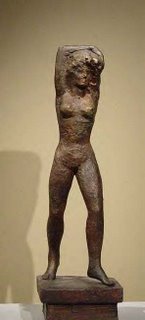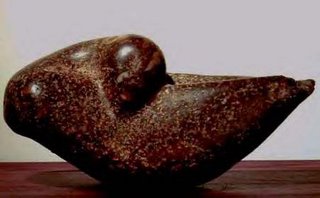R.H. Love gallery of American art
Richard Love has a gallery of American painting (and some sculpture)
from the 19th C. up to 1950. It's been around since the 70's -- and hearing a radio ad for it's 're-discoverery' of the painter, Augustus Dunbier -- I finally paid a visit -- a total delight. Most of the paintings are 20th C. landscapes -- many of them midwestern - and there were many endearing moments. ( The Union League Club also has a large collection of this genre -- but I remember them as dim and murky -- maybe they just needed cleaning.)
Overall -- the collection was similar -- but a step above the best of my art club --
while being a step below the Twachtman or Hassam from the A.I.C.. The paintings were like beautiful women seen passing on the street --- their particularities enjoyable for a moment -- but not needing to be seen week-after-week.
 The star of the show, Dunbier, had a fine masculine aesthetic -- and the effects of his thick paint are mostly lost in reproduction. In person, the above painting is magic -- but in reproduction it looks less than ordinary. The thick-paint-daubing approach dominated American landscape painting in the late 19th and early 20th century -- it doesn't reproduce very well -- and I admit to never having liked it much. But now that it's a relic of the past -- I'm starting to enjoy it more.
The star of the show, Dunbier, had a fine masculine aesthetic -- and the effects of his thick paint are mostly lost in reproduction. In person, the above painting is magic -- but in reproduction it looks less than ordinary. The thick-paint-daubing approach dominated American landscape painting in the late 19th and early 20th century -- it doesn't reproduce very well -- and I admit to never having liked it much. But now that it's a relic of the past -- I'm starting to enjoy it more.
 I didn't see this portrait on display -- but I think it shows the quality of his figure drawing - even if the arrangement feels a bit like a jumble.
I didn't see this portrait on display -- but I think it shows the quality of his figure drawing - even if the arrangement feels a bit like a jumble.
The sculptor who caught my eye was Boris Lovet-Lorski (1894-1973) -- a Latvian aristrocrat who fled the Soviet Union after the revolution and ended up mostly in New York.The show had two over-life-size heads of famous men (Schweitzer and Stokowski)whose monumental feeling is not communicated by the photos provided by the gallery. (the images seen below were found on various websites)
 I think this head of Ike shows he was a sensitive and idealistic portraitist.
I think this head of Ike shows he was a sensitive and idealistic portraitist.
 while his figure studies have unique proportions and seem to hover at the delicate boundary between simply powerful and simply boring. Like me, I think he had difficulty designing a free standing figure in space.
while his figure studies have unique proportions and seem to hover at the delicate boundary between simply powerful and simply boring. Like me, I think he had difficulty designing a free standing figure in space.
 Here's what must have been his respone to Brancusi ("Bird at rest"). He
Here's what must have been his respone to Brancusi ("Bird at rest"). He
joined many NY sculptors of his time (like Zorach) in carving simplified figures in stone -- until arthritis drove him back to clay modeling. This one looks like Eskimo art -- doesn't it ? (except that it feels cold instead of warm --Eskimos are into warmth)
from the 19th C. up to 1950. It's been around since the 70's -- and hearing a radio ad for it's 're-discoverery' of the painter, Augustus Dunbier -- I finally paid a visit -- a total delight. Most of the paintings are 20th C. landscapes -- many of them midwestern - and there were many endearing moments. ( The Union League Club also has a large collection of this genre -- but I remember them as dim and murky -- maybe they just needed cleaning.)
Overall -- the collection was similar -- but a step above the best of my art club --
while being a step below the Twachtman or Hassam from the A.I.C.. The paintings were like beautiful women seen passing on the street --- their particularities enjoyable for a moment -- but not needing to be seen week-after-week.
 The star of the show, Dunbier, had a fine masculine aesthetic -- and the effects of his thick paint are mostly lost in reproduction. In person, the above painting is magic -- but in reproduction it looks less than ordinary. The thick-paint-daubing approach dominated American landscape painting in the late 19th and early 20th century -- it doesn't reproduce very well -- and I admit to never having liked it much. But now that it's a relic of the past -- I'm starting to enjoy it more.
The star of the show, Dunbier, had a fine masculine aesthetic -- and the effects of his thick paint are mostly lost in reproduction. In person, the above painting is magic -- but in reproduction it looks less than ordinary. The thick-paint-daubing approach dominated American landscape painting in the late 19th and early 20th century -- it doesn't reproduce very well -- and I admit to never having liked it much. But now that it's a relic of the past -- I'm starting to enjoy it more.  I didn't see this portrait on display -- but I think it shows the quality of his figure drawing - even if the arrangement feels a bit like a jumble.
I didn't see this portrait on display -- but I think it shows the quality of his figure drawing - even if the arrangement feels a bit like a jumble. The sculptor who caught my eye was Boris Lovet-Lorski (1894-1973) -- a Latvian aristrocrat who fled the Soviet Union after the revolution and ended up mostly in New York.The show had two over-life-size heads of famous men (Schweitzer and Stokowski)whose monumental feeling is not communicated by the photos provided by the gallery. (the images seen below were found on various websites)
 I think this head of Ike shows he was a sensitive and idealistic portraitist.
I think this head of Ike shows he was a sensitive and idealistic portraitist.  while his figure studies have unique proportions and seem to hover at the delicate boundary between simply powerful and simply boring. Like me, I think he had difficulty designing a free standing figure in space.
while his figure studies have unique proportions and seem to hover at the delicate boundary between simply powerful and simply boring. Like me, I think he had difficulty designing a free standing figure in space.  Here's what must have been his respone to Brancusi ("Bird at rest"). He
Here's what must have been his respone to Brancusi ("Bird at rest"). Hejoined many NY sculptors of his time (like Zorach) in carving simplified figures in stone -- until arthritis drove him back to clay modeling. This one looks like Eskimo art -- doesn't it ? (except that it feels cold instead of warm --Eskimos are into warmth)


0 Comments:
Post a Comment
<< Home